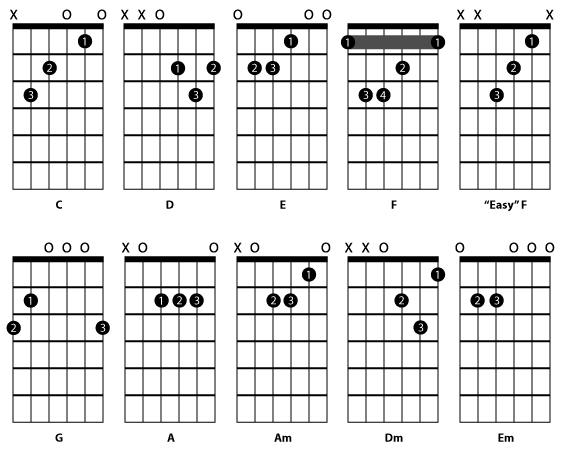Learning To Play the Guitar Pt. 2

November 2, 2017
In this week’s edition of “Learning Guitar Basics,” we will cover the basics of tuning and some of the basic guitar chords.
Tuning: Playing a guitar that is out of tune is never enjoyable, and it will prevent you from learning how to really play. In order to tune your instrument, you must be able to recognize that the strings are arranged from lowest to highest pitch, or from the thickest to thinnest strings respectively. Starting from the lowest, the strings are named E, A, D, G, B, and E. A good acronym to remember this is Eat All Day, Get Big Easy. To tune your instrument, tighten or loosen your strings by twisting the tuning pegs forward or back accordingly until they match their correct name. You can use an electronic tuner to help you identify if your strings are tight enough to be tuned, or you can play what each string sounds like on youtube or other devices, and try to match the corresponding pitches to the strings by ear.
Basic Chords: Chords are sets of notes that are created by strumming all of the strings in one motion, while holding a specific finger placement on the fretboard of the guitar. Some of the most basic chords to learn when you are first starting out are C Major, A Major, G Major, E Major, and D Major. Before playing, it’s important to remember that the string closest to the floor while holding the guitar—the thinnest string—is the 1st string. Once you read through the ways to play the basic chords, you can refer to the bottom of the page for visual aid.
To play C Major: Place your ring finger on the 3rd fret of the 5th string (A). Then, place your middle finger on the 2nd fret of the 4th string (D). Finally, place your index finger on the 1st fret of the 2nd string (B).
To play A Major: Place your pointer finger on the 2nd fret of the 4th string (D). After, place your middle finger on the 2nd fret of the 3rd string (G). Finally, place your ring finger on the 2nd fret of the 2nd string (B).
To play G Major: First, place your ring finger on the third fret of the first string (E). Place your index finger on the second fret of the fifth string (A). Conclude by placing your middle finger on the third fret of the sixth string (E).
To play E Major: Begin by placing your second finger (middle) on the second fret of the A string. Next, place your ring finger down on the second fret of the D string. Finally, place your index finger on the first fret of the G string.
To play D Major: Place your index finger on the second fret of the third string (G). After, place your middle finger on the second fret of the first string (E). Then, place your ring finger on the third fret of the second string (B).
Photo Credit: Six Strings Sensei